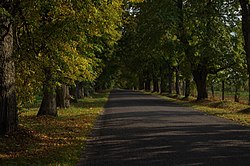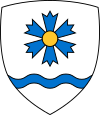
Tartu is the second largest city in Estonia after Tallinn. Tartu has a population of 97,435. It is 186 kilometres southeast of Tallinn and 245 kilometres northeast of Riga, Latvia. Tartu lies on the Emajõgi river, which connects the two largest lakes in Estonia, Lake Võrtsjärv and Lake Peipus. From the 13th century until the end of the 19th century, Tartu was known in most of the world by variants of its historical name Dorpat.

Viljandi is a town and municipality in southern Estonia with a population of 17,407 in 2019. It is the capital of Viljandi County and is geographically located between two major Estonian cities, Pärnu and Tartu. The town was first mentioned in 1283, upon being granted its town charter by Wilhelm von Endorpe. The town became a member of the Hanseatic League at the beginning of the 14th century, and is one of five Estonian towns and cities in the league. The once influential Estonian newspaper Sakala was founded in Viljandi in 1878.

Harju County, is one of the fifteen counties of Estonia. It is situated in northern Estonia, on the southern coast of the Gulf of Finland, and borders Lääne-Viru County to the east, Järva County to the southeast, Rapla County to the south, and Lääne County to the southwest. The capital and largest city of Estonia, Tallinn, is situated in Harju County. Harju is the largest county in Estonia in terms of population, as almost half (45%) of Estonia's population lives in Harju County.
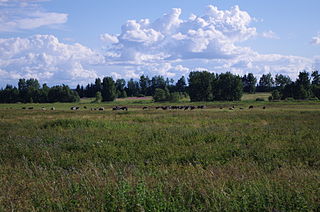
Tartu County is one of 15 counties of Estonia.

Valga County is a first-level administrative unit and one of 15 counties of Estonia. It comprises the former area of Valga District. The present-day county was created on 1 January 1990. The capital and largest town of Valga County is Valga, followed by Tõrva and Otepää. It is situated in the southern part of the country and borders Põlva and Võru County to the east, Latvia to the south and west, and Viljandi and Tartu County to the north. 27,650 people live in Valga County as of 2022.

Kambja is a small borough in Tartu County, Estonia. It is the administrative centre of Kambja Parish.

Jõgeva is a small town in Estonia with a population of around 5000 people. It is the capital of Jõgeva Parish and Jõgeva County.

Tartu Parish is a rural municipality in Tartu County, Estonia. It has a population of 12,725 and covers an area of 742 km2 (286 sq mi). The population density is 17.150/km2 (44.42/sq mi). It has one borough (Raadi), six small boroughs and 70 villages.

Vändra is a borough in Põhja-Pärnumaa Parish in Pärnu County, Estonia. It has a population of 2,191 and an area of 3.28 km².
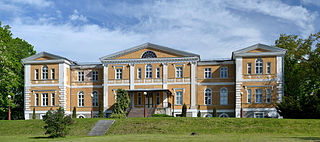
Kuremaa is a small borough in Jõgeva Parish, Jõgeva County in eastern Estonia. It lies 10 km from Jõgeva, near the northern shore of Lake Kuremaa, the 11th largest lake in Estonia. Kuremaa features an estate that was owned by the von Oettingen family until the early 20th century. Part of the estate's manor house is now a museum, its windmill in neighbouring Mooritsa village is a popular landmark, and its terraced gardens reach down to the shore of Lake Kuremaa.
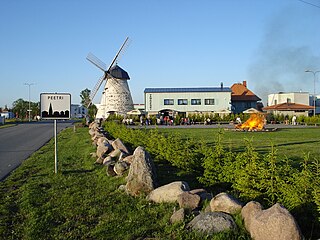
Peetri is a small borough in Rae Parish, Harju County, in northern Estonia. It is bordered by the city of Tallinn.

Vaida is a small borough in Rae Parish, Harju County, northern Estonia. It's located about 21 km (13 mi) southeast of the capital Tallinn, by the Tallinn–Tartu road (E263). Vaida has a population of 990.

Jüri is a small borough in Harju County, northern Estonia. It is located 12 km (7.5 mi) southeast of the capital Tallinn, by the Tallinn–Tartu road (E263), directly after the intersection with Tallinn Ring Road. Jüri is the administrative centre of Rae Parish. Jüri has a population of 3,594 as of 1 June 2023. In 2011, Jüri was the center of population of Estonia.

Palamuse is a small borough in Jõgeva County, in Jõgeva Parish, Estonia, located about 12 km (7 mi) southeast of the town of Jõgeva. It is passed by the Amme River. With a population of 551
Kammeri is a village in Kambja Parish, Tartu County in southern Estonia, located about 23 km south of the city of Tartu. In 2000 Kammeri had a population of 92.
Külitse is a small borough in Kambja Parish, Tartu County, in southern Estonia. It is located about 6 km southwest of the city of Tartu by the Tartu–Valga–Riga railway and the European route E264. Külitse has a population of 600.

Raadi-Kruusamäe, or Raadi for short, is a neighbourhood of Tartu, Estonia. It has a population of 4,498 and an area of 2.83 km2 (1.09 sq mi). Raadi is mainly suburban area.

Saadjärve is a village in Tartu Parish, Tartu County in Estonia. It is located about 17 km north of the city of Tartu, on the eastern shore of Lake Saadjärv. Saadjärve has a population of 118.

Kobela is a small borough in Võru County, in southeastern Estonia, located about 3 km (2 mi) northwest of the town of Antsla, near the Lake Vahtsõkivi. As of the 2011 census, the settlement's population was 313.

Lombi is a village in the municipality of Tartu, Tartu County, Estonia.
